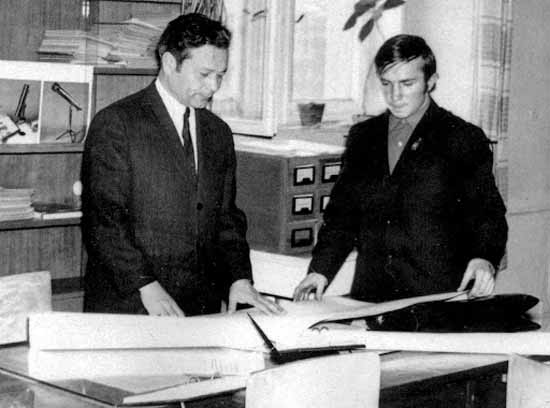Polytechnical institutes
Polytechnical institutes (політехнічні інститути; politekhnichni instytuty). Institutions of higher education that provide an innovation-oriented instruction mainly in engineering, applied science, and technology, particularly in their practical application in manufacturing and other industries. Typically, they train engineers in a variety of fields of industry and technology, such as machine building, radio electronics, instrument engineering, metallurgy, energetics, chemical engineering, mining, applied material science, petroleum industry, transportation, construction, electrical engineering, software engineering, information technology, and others. Polytechnical institutes were the main institutions of technical higher learning in Soviet Ukraine. In independent Ukraine, the majority of polytechnical institutes and their regional branches were reorganized into technical universities during the 1990s, although some of them retained the phrases ‘polytechnical institute’ or ‘polytechnic’ in their new names.
The oldest polytechnical school of higher education on the territory of present-day Ukraine (and the oldest on the territory of the former USSR) was founded in Lviv as a technical academy in 1844 on the basis of an Austrian Realschule. From 1872 it was called the Lviv Higher Polytechnical School and from 1921 the Lviv Polytechnic. In 1919 the Dubliany Agricultural Academy (est 1891) and the Lviv School of Forestry (est 1874) were incorporated into the school’s Department of Agriculture and Forestry. In 1939, following the Soviet invasion of Western Ukraine, the school was renamed Lviv Polytechnical Institute (now it is Lviv Polytechnic National University). In Russian-ruled Ukraine, the oldest polytechnical institute was founded in 1885 in Kharkiv under the name the Kharkiv Technological Institute. In 1929 it was reorganized into Kharkiv Polytechnical Institute. In 1930 it was replaced by a number of specialized institutes—mechanical, electrical, chemical, civil engineering, and aviation—but it was restored in 1949 (now it is Kharkiv Polytechnical Institute National Technical University). Kyiv Polytechnical Institute was founded in 1898 and soon it became one of the chief polytechnical schools in the Russian Empire (now it is Kyiv Polytechnical Institute National Technical University of Ukraine). Two more higher polytechnical schools were opened in the wake of the Revolution of 1917. In 1918 a polytechnical institute was established in Odesa (between 1933 and 1945 known as Odesa Industrial Institute; today it is Odesa Polytechnic National University). In 1921 the Mining Tekhnikum (then an institution of higher education) was opened in Donetsk. It was renamed the Artem Mining Institute in 1926, Stalino Industrial Institute in 1935, and Donetsk Polytechnical Institute in 1960 (today it is Donetsk National Technical University). It was the largest Soviet-era institution of higher learning in the Donets Basin.
Polytechnical education was considered to be a central element of the Marxist-Leninist theory of education, as set forth in the 1919 Eighth Congress of the Russian Communist Party (Bolshevik). In the early Soviet period the existing polytechnical institutes were split into a number of specialized institutes—mechanical, electrical, chemical, civil engineering, and others—but were largely restored in the 1940s. In 1958 the Ukrainian Correspondence Polytechnical Institute was opened in Kharkiv; it is currently the Ukrainian Engineering-Pedagogical Academy. The last polytechnical institute to be open in Soviet Ukraine (in 1974) was Vinnytsia Polytechnical Institute (formerly a branch of Kyiv Polytechnical Institute; now it is Vinnytsia National Technical University). By the mid-1980s there were 7 polytechnical institutes and 2 industrial institutes in Soviet Ukraine. They tended to have large enrollments (in 1985, Kyiv Polytechnical Institute had more than 31,000 students, Lviv Polytechnical Institute, 27,000, and Kharkiv Polytechnical Institute, 25,000). Most polytechnical institutes had branches or satellite campuses in other cities. For instance, Kyiv Polytechnical Institute had its branches in Vinnytsia (1964–74), Zhytomyr (opened in 1960), Chernihiv (opened in 1960), and Cherkasy (opened in 1979). Lviv Polytechnical Institute had its branches in Ternopil (opened in 1964) and Lutsk (opened in 1975). Kharkiv Polytechnical Institute had its branches in Kirovohrad (opened in 1962), Sumy (opened in 1966), and Kremenchuk (opened in 1974). Odesa Polytechnical Institute had a branch in Sevastopol (opened in 1963). Donetsk Polytechnical Institute had its branches in Horlivka and Torez (both opened in 1960), Makiivka (1947), and Kramatorsk (opened in 1953).
In independent Ukraine a number of new ‘technical or technological universities’ were opened on the basis of former specialized technical institutes or regional branches of polytechnical institutes, among them in Mariupol (1993), Dniprodzerzhynsk (1994), Poltava (1994), Zaporizhia (1994), Khmelnytskyi (1994, renamed Khmelnytskyi National University in 2004), Sevastopol (1994), Ternopil (1996), Lutsk (1997), Kherson (1997), Kirovohrad (1998), Rivne (1998, renamed the National University of Water and Environmental Engineering in 2004), Chernihiv (1999), Kremenchuk (2000, renamed Kremenchuk National University in 2010), Cherkasy (2001), Zhytomyr (2003), Mykolaiv (2003), Alchevsk (2004, relocated to Lysychansk in 2014), and Dnipro (2017; see Dnipro University of Technology).
In addition to training engineers, most technical universities in Ukraine, in response to market demands, have opened programs in business, economy, social sciences, and the humanities. Lviv Polytechnic National University and Kyiv Polytechnical Institute National Technical University of Ukraine remain the largest by enrollment and have 25,500 and 25,000 students respectively. Virtually all aforementioned institutions are state-funded and are under the jurisdiction of the Ministry of Education and Science of Ukraine. There are also occasional private polytechnical institutes, such as the one in Nova Kakhovka (est 1999) and the ‘Metinvest-Politekhnika’ in Mariupol funded by the local metallurgical group Metinvest (to be inaugurated in 2022 with an innovative campus designed by a Dutch architectural firm and an information technology infrastructure to be provided by the Microsoft).
The leading research-intensive technical universities in Ukraine are consistently ranked among the country’s best institutions of higher learning. For instance, in the 2021 Consolidated Ranking of all Ukrainian institutions of higher learning (more than 240 featured) by the influential educational web portal Osvita.ua, Kyiv Polytechnical Institute National Technical University of Ukraine is ranked 2nd and Lviv Polytechnic National University is ranked 6th.
Serhiy Bilenky
[This article was updated in 2021.]

.jpg)